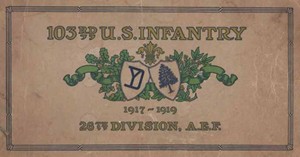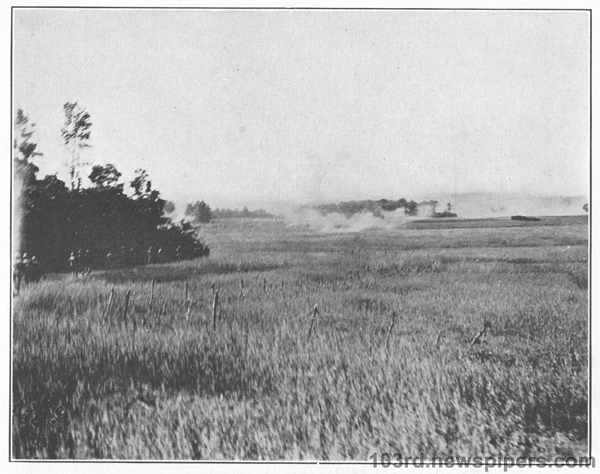
of the 26th Division of the U.S. Army
during World War I
 | The History of the 103rd Regiment of the 26th Division of the U.S. Army during World War I |
| Table of Contents | ||
CHAPTER VI
CH .\TEAU—TH I ERRY
A VVORLD of memories comes to mind with these two words,—Ch:iteau-
Thierry, And rightly, for there the tide was turned, and with ever-increas-
ing force to the very end, on November ll, that tide rolled back the German
armies and brought victory to the Allies.
The eyes of the world were first focusetl on Chateau-Thierry when, those last
days of May and the month of June, disaster seemed to face us and the 2nd
Division so nobly played its part in blocking the threatened breach and regain-
ing some of the ground lost. But there a still greater significance for men of
the 25th Division and the 103rd Infantry, and that is that they launched the
counter attack of July 18, which electrified the world, which, thanks to Foch’s
genius, turned an enemy victory to a rout, broke down the morale of Germany,
and was the beginning of a fairer day.
VVhat was the general situation? Quoting from an article in Harpcfs of
December, 1918 ("l\/Iarshall Foch and thc Second Victory of the Marnc" by
Raymond Recouly):
"The German army, mightily strengthened in morale as well as materially
through the defcction of Russia, and in full possession of all its resources and
means of offense, fell upon the English with terrific force on the 21st of March,
1918, and upon the French on the 27th of May,
"The third German onslaught was on the 15th of July, when Ludendorff
threw all his forces against the Allied lines, from Chftteau—Thierry as far as the
Main de Massiges, to the east of Rhcims. But this time the furious assault was
stopped short; advance was impossible except at one point of our center, and
almost at once Foch delivered a thrust in return which was irresistible and 0ver—
whelming. The French and American troops counter-attacked on the 18th of
July, and from the first this counter·oFfensive, which took the Germans corn-
pletely by surprise, was a brilliant success. The enemy, jostled and confused,
abandoned a wide stretch of territory, losing many thousands of prisoners; and
as their communications were threatened they made all haste to retreat, falling
back from the Marne, which they had so irnprudently crossed, as far as the
Aisne. Thus they lost nearly all the ground which they had wrestcd from us,
and the great railway from Paris to Nancy was ours again.
"It would be in vain to search the pages of military history for another ex—
ample of such a sudden change, for none can be found. It is this reversal of con-
ditions which we call, and with full justification, The Second Victory of the
Marne, To the same extent as in the first victory of 1914 the situation of the
Allies, from seeming almost desperate, became favorable materially and also as
to morale; the pressure of the German power was broken and the liberty and
the civihzation of the world were saved."
\Vhat was this regiment’s share in this wonderful event?
Before answering this directly it will be well to see briefly just what took
place upon leaving Toul. Entraining the twenty—seventh, twenty-eighth, and
twenty-ninth from the city of Toul, the regiment moved to La Ferte northeast
of Meaux, from which place the several battalions marched to temporary des-
tinations: Regimental Headquarters to Saacy; the lst Battalion to Lizy·sur-
 Ourcq; the 2nd Battalion to Citry; thc 3rd Battalion to Saacy, all villages on
or in thc immediate vivinity of the Marne and not more than ton kilomctcrs
from the front. But their rest was short for Rt-·giynt-intal moved to Montrenil the
fifth; the- lst Battalion niovvtl into Bois dt- (iros Joan, —the support position
for Belleau Wootls. ’l`lur 2nd lint talion rcliovvtl tho Marinas in Bvllt-au \\`oods on
tho fifth, and thc 3rd liitttalion, tho Marines in rost—rvo in thc woods northwest
of Montrvuil. Things moved fast those days. Tho lst Battalion took over thc
front line July 12, relieving thc- 2nd. wliirh wont into reservv in woods ncnr
\`oie—du-Cliatel, the 3rd Battalion moving into support in the woods northwest
of Lucy.
The very atmosphere see·m<··
Ourcq; the 2nd Battalion to Citry; thc 3rd Battalion to Saacy, all villages on
or in thc immediate vivinity of the Marne and not more than ton kilomctcrs
from the front. But their rest was short for Rt-·giynt-intal moved to Montrenil the
fifth; the- lst Battalion niovvtl into Bois dt- (iros Joan, —the support position
for Belleau Wootls. ’l`lur 2nd lint talion rcliovvtl tho Marinas in Bvllt-au \\`oods on
tho fifth, and thc 3rd liitttalion, tho Marines in rost—rvo in thc woods northwest
of Montrvuil. Things moved fast those days. Tho lst Battalion took over thc
front line July 12, relieving thc- 2nd. wliirh wont into reservv in woods ncnr
\`oie—du-Cliatel, the 3rd Battalion moving into support in the woods northwest
of Lucy.
The very atmosphere see·m<·· |
||
| Original Version of Page |